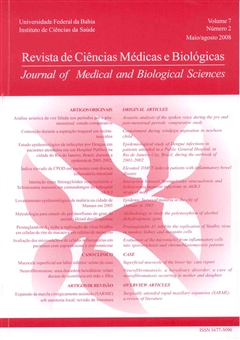Containment during windpipe aspiration in newborn child
DOI:
https://doi.org/10.9771/cmbio.v7i2.4439Keywords:
Containment, Windpipe aspiration, Newborn infants.Abstract
Objective: Evaluate the effect of the containment maneuver during the procedure of windpipe secretion aspiration in newborn. Materials and methods: Randomized clinical assay. Sample: all newborns that had needed aspiration in the UTIN of a hospital of Salvador-BA. Independent variable: containment and dependents: variation of FC, SpO2 and presence of pain. Work approved for the CEP. Each newborn received two procedures: aspiration with containment (group intervention) and only aspiration (group has controlled). For variable FC and SpO2 the value of variation of the parameter was used. Already for the pain evaluation the NFCS was applied. The used statistical tests had been T Student, Mann Whitney and Qui-square in accordance with characteristic of the variable. Results: The average of the FC in intervention group was 24bpm, whereas in controlled group was 57bpm (p < 0,0001). Comparing the variation of the SpO2, it was noticed that medium of intervention group was 2%, whereas in controlled group was 7% (p=0,0056). They presented pain 23% of contained newborn and not contained 92% (p=0,0015). Conclusion: The study demonstrated that the containment of newborn during the windpipe aspiration promotes the stabilization and reduction of clinical pain, minimizing the complications that can be caused by this procedure.Downloads
Download data is not yet available.
Downloads
Published
2008-09-16
How to Cite
Falcão, F. R. C., & Silva, M. A. B. (2008). Containment during windpipe aspiration in newborn child. Journal of Medical and Biological Sciences, 7(2), 123–131. https://doi.org/10.9771/cmbio.v7i2.4439
Issue
Section
ORIGINAL ARTICLES
License
The Journal of Medical and Biological Sciences reserves all copyrights of published works, including translations, allowing, however, their subsequent reproduction as transcription, with proper citation of source, through the Creative Commons license. The periodical has free and free access.


